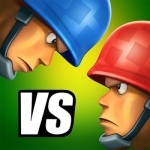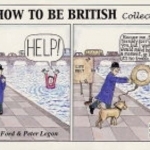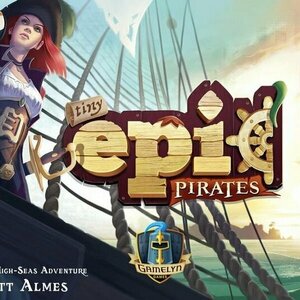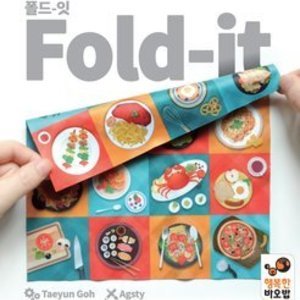
Zombie Hunter: FPS Apocalypse
Games and Entertainment
App
The new real zombie war game with incredible 3D graphics. Your goal is to survive from the undead...

Mighty Battles
Games
App
Who's the Mightiest? Shoot, Deploy and Destroy in the Real-time 1v1 Battles! YOUR MISSION As...

Splendor™
Games
App
** ONLINE MULTIPLAYER NOW AVAILABLE !!! ** The OFFICIAL digital adaptation of the best-selling...
BoardGames BoardgameApps GreatGames

The How to be British Collection
Book
A perennially popular collection of colour cartoon illustrations, with accompanying texts, on the...
Purple Phoenix Games (2266 KP) rated Fossilis in Tabletop Games
Feb 17, 2021
Fossilis is a game of set collection and tile placement in which players are working to excavate and collect sets of dinosaur bones for display in museums across the world. To setup for a game, prepare the dig site as described in the rulebook. Populate the Score Track board with 9 random Skill tokens, 3 face-down randomly selected Event cards, and a Plaster pool based on the player count. Create a Market of Tool and Supply cards, as well as a Dinosaur Display. Each player receives a mat, Paleontologist meeple, and score marker in their chosen color. Pick a starting player, and in reverse turn order, players place their Paleontologists onto a corner tile of the dig site. The game is now ready to begin!
Every players’ turn has 3 steps: Actions, Market, and Lab. At the start of your turn, you have 4 Energy to spend on Actions. The available action choices are: Gain 1 Plaster (from the Plaster pool), Move up to 2 spaces (orthogonally or diagonally), Climb onto the Dig Site (if your Paleontologist was knocked off the board), Place 1 Sand tile (anywhere on the Dig Site), Dig 1 tile (slide a terrain tile 1 space in any direction), or Extract (excavate a bone/hammer). With the exception of Digging, all other Actions cost 1 Energy to perform. Digging 1 tile costs energy dependent on the type of terrain tile being moved. To dig Sand is 1 Energy, Clay is 2, and Stone is 3. To Dig, you select 1 tile that is orthogonally adjacent to your Paleontologist, and slide it 1 space in any direction you wish. Tiles that are pushed off the edge are claimed by that player, and can be used to purchase cards from the Market. It is possible for a Paleontologist to be pushed off the Dig Site, so watch out! To perform the Extract action, you will excavate a bone or hammer from an open pit orthogonally adjacent to your Paleontologist. Extraction costs Plaster dependent on the type of bone being collected. For example, extracting a tooth costs 2 Plaster, while a skull costs 6. Extracting hammers has no cost, and you immediately trade the hammer for one of the available Skill tokens in play. The Skill tokens provide benefits for the remainder of the game. Once a player has spent their Energy, they move to the next phase.
On your turn, you may buy 1 card from the Market: either a Tool or Supply card. These are purchased using the icons on any tiles you collected during the Action phase. Supply cards gain you immediate resources, while Tool cards are saved for use during a future Action step. After the Market phase is the Lab phase. You may claim a Dinosaur from the Display if you have at least one of the required bones for that Dinosaur. You can only ever have 1 Dinosaur in your Lab at a time, so strategize carefully. At any point during a turn, you can score the Dinosaur in your lab – either for full points if all required bones are present on the card, or partial points if you only have some of the required bones.
Events are triggered 3 times throughout the game when the Plaster pool has been depleted. The active player draws the top Event card, and follows the instructions on the card. Once an Event has been performed, the Plaster pool is refilled and play continues with the next player. After the 3rd event has been triggered, the Plaster pool is refilled one last time. When the last Plaster pool is depleted for this final time, the game ends. Players count up all their points, and the player with the highest score wins!
At first it may seem overwhelming, like there is a lot going on, but after a couple of turns the gameplay feels intuitive and streamlined. There are quite a few aspects to keep track of, but the overall flow of the game makes it feel clear and concise. During my plays, I have never once felt lost or confused as to what the next turn step is. The tight gameplay also lends itself to providing a variety of strategic options for players. Do you want to go for all the highest-scoring Dinosaurs, even though their bones take longer to collect? Or maybe you want to snag as many lower-scoring Dinosaurs as possible, since they should be faster to collect. You can earn end-game points based on Characteristic sets of Dinosaurs (carnivorous, herbivore, etc), so maybe you decide to focus on those sets. Or if you’re in a particularly confrontational mood, maybe you want to knock opposing Paleontologists off the Dig Site, causing them to ‘waste’ an Energy on a future turn just to climb back on into the play area. There really is no right answer as to what strategy is a sure-win, and I like that I can choose and adapt my strategies based on the current standings in the game.
Probably my favorite innovative mechanic in Fossilis is the 3D terrain and ‘digging’ actions. When setting up the game, bones and hammers are randomly scattered and distributed around the Dig Site before terrain tiles are added. So there is absolutely no way to know where you should dig for what you want! Just like a real paleontologist, you’ve got to give it your best guess. I have had some frustrating turns, spending lots of Energy to dig a tile just to find the space to be empty! Or maybe you dig and hit the motherlode, which just means you’ll probably have to fight off other paleontologists for the bones that you need. The 3D board adds another element of strategy that heightens the gameplay and makes it more immersive.
Let’s touch on components for a moment. They are AWESOME. Admittedly, I have the Kickstarter version, but I just love how well-produced this game is. The terrain tiles are nice and thick bakelite-esque tiles, and they are just dang fun to manipulate. The plaster and bones are small, but pretty detailed and sturdy for their size. The artwork on the cards is colorful and clear, the Paleontologist meeples are cute little wooden bits, and the cardboard bits are all good quality. Excellent production quality all around.
It should come as no surprise, based on my score, that I love this game. The gameplay is immersive and engaging, the mechanics add a neat twist to your normal set collection/tile placement game, and the ability to adapt strategy on the fly means that nobody is truly out of the game because of one bad turn. Purple Phoenix Games gives Fossilis a roaring 11 / 12. If you’re looking for a good dinosaur game, look no further. Yeah, they’re technically just bones here, but it still counts!

Global Teams: How the Best Teams Achieve High Performance
Book
Working for a matrix international organisation, with its ensuing diverse global teams, based in a...

I.N.S.P.I.R.E.
Book
Are you tired of change initiatives falling flat? Frustrated by resistance and lackluster results?...
Purple Phoenix Games (2266 KP) rated Tiny Epic Pirates in Tabletop Games
Dec 28, 2021
Disclaimer: I do not intend to rehash the entire rulebook in this review, but rather provide a general overview of the rules and gameplay. -L
Tiny Epic Pirates is a competitive game in which players take on the roles of pirate captains sailing the seas, engaging in combat, trading at various ports, and trying to bury some treasure. Played over a series of rounds, the game ends once a player has buried their 3rd treasure chest. To setup, follow the instructions as detailed in the rulebook – there are simply too many to outline here concisely. Two unique aspects of setup are that the Map cards are shuffled and randomly placed in a 4×4 grid, ensuring a variable setup for each game. The other is that each player will also randomly assign Order tokens on their Wheel (rondel), which means that no two players will have the same setup for a game. Once the Sea has been created, players have prepared their appropriate mats, a market for Booty and Crew have been setup, and tokens/Ships are placed on the map, the game is ready to begin!
Each turn is broken down into 5 steps: Captain’s Order/Deckhands, Sail, Execute Captain’s Order, Trigger Bonus Actions, and Crossing the Ship Line. The first part of every turn is to move your Captain meeple clockwise on your Wheel to select your Captain’s Order for this turn. Moving to the next adjacent space is free, but to skip spaces you must place Deckhand meeples onto the skipped spaces. In future turns, you may have Deckhands coming off the wheel, and you will assign those to other tasks during this step. The next step is to Sail your ship. Every player begins the game with a base speed of 1 Map card, and this can be enhanced throughout gameplay. During this step, you may Sail your ship across Map tiles up to your total allowed distance. After having Sailed, it is time to Execute Captain’s Order. To do this, refer back to your Wheel to see which action your Captain is on, and perform it. Possible actions are to Plunder (steal Booty from settlements), Trade (trade Booty for $ at markets), Crew Up (add up to 4 Crew members to your Ship), Search (gain a one-time benefit from un-searched Map cards), Attack (attack opposing Pirates or Merchant ships at sea), or Hide Out (rest at a Cove and reassign all Deckhands). You may only perform the action that was selected in the Captain’s Order step, regardless of if your placement on a Map card has other actions available.
Once your selected action has been performed, the next step is to Trigger Bonus Actions. Looking at your Captain and Crew cards, if their leftmost icon matches your current Captain’s Order, you may trigger the listed bonus actions. Some bonus actions allow you to perform duplicate Captain’s Orders, but others will earn you money, let you reassign Deckhands, exchange Booty at a different rate, and bury treasure. You don’t need to perform every Bonus Action listed if you so choose, but they may only be performed when their card icon matches your Captain’s Order. The very last step of your turn is to see if you have Crossed the Ship Line. Check your Wheel and see if you have moved from space 5 across the Ship Line to start another circle around the Wheel. If you did not cross the line, then your turn ends and play moves to the next Pirate. If you did cross the Ship Line, then the Merchant and Navy ships will sail a set amount of distance. Merchant ships are simply trying to deliver goods to port, and will be traversing the sea throughout the game. The Navy ship is hunting down Pirates, and will move to attack the current player any time the Ship Line is crossed. When a player has buried their third and final treasure, the round finishes as normal and the game ends. The player who buried all 3 treasures is the winner! In the case of a tie, check the rulebook. 😉
As with most of the Tiny Epic games, I will first start by saying that the size of the box may be small, but the gameplay inside is enormous. There is so much strategy in this one, I think it’s the ‘heaviest’ one in the series so far. You have so many different choices when it comes to strategy, and the gameplay will feel different every time. You could choose to take the offensive and be the aggressor, attacking any and all Ships that you can. Winning combat against Merchant Ships earns you Booty and other resources, while winning combat against opposing Pirates earns you Legend Levels. Your current Legend Level dictates how many spaces you are allowed to Sail, as well as how many dice you can roll during combat. So increasing that level results in better benefits. Maybe you just want to be an honest Pirate and do all of your trading at legal markets, avoiding contact with others and trying to skirt around combat. Maybe you want to try a little of both? The point is, you have choices, and must be able to adapt them based on your opponents’ decisions as well.
A neat element I touched on earlier about this game is the variable setup for each individual player and their Wheel. This really factors into your strategy because you have to know when to use which actions. Do you use a Deckhand to skip a space, or do you burn a turn moving for free to keep that Deckhand right where you want him? And remember, Bonus Actions are only triggered when the matching Captain’s Order is selected, so maybe you have to sacrifice acting in a turn (not being able to perform the selected Captain’s Order) in order to trigger your desired Bonus Action. It’s all about strategy, and that keeps the gameplay engaging at all times.
Just a word of warning though, there is a bit of a learning curve, as there are so many steps and items to consider each turn. Thus the gameplay felt pretty daunting and slow-going my first few plays. But as I became more comfortable with the turn structure and the iconography, it became easier to know what comes next. Another thing to consider is player count. Playing Tiny Epic Pirates at 2 players didn’t really feel that immersive or engaging. With only 2 players on a 4×4 grid, it can be easy to completely avoid each other and skirt around, essentially playing by yourself in a way. With 3 and 4 players, there are more Ships on the map and more opportunities for player interactions and engagement. So it all comes down to what kind of gameplay you want, when selecting your player count.
Components. Again, so far all the Tiny Epic games have had awesome production quality and Tiny Epic Pirates is no exception. The artwork is bright and colorful, the cards and cardboard tokens are sturdy, the meeples are cute, and the actual ships are fun to play with. My only qualms are that two of the player colors – black and blue – are visually similar so in setup it can be tricky to tell them apart. Another qualm is that two of the Booty types (teehee) are a tan and gray color, and the iconography for both on the Map cards are similarly colored. The first few plays I found myself trading the wrong Booty at market because I didn’t check the icon closely enough. These are not game-breakers by any means, but just a heads up so you’re paying attention! As this was a Kickstarter, I did opt for the add-on Pirate Skull dice, and have to honestly say that I prefer the regular game dice better. The ‘knots’ on the corners of the skull dice stop them from continuing to roll, so I felt like I wasn’t really getting a real roll on them. Maybe that’s just my personal opinion, but the regular ol’ game dice are perfectly fine.
How does Tiny Epic Pirates fare in the lineup of the Tiny Epic games? Fairly well, I would say. It’s not one that I would pull out to play with just anybody, as it is a bit of a heavier game, but it is one that I know I would enjoy with my game group. There are a lot of neat elements and mechanics at play here that really work well together and make for an engaging and kind of brain-burning (in a way) game. Although Tiny Epic Pirates might not get as much playtime for me as others in the series, it’s a good one to have and it really embodies the tiny (small box, check) and epic (sweet and strategic gameplay) parts of the title. Purple Phoenix Games gives this one a seaworthy 4 / 6.
Purple Phoenix Games (2266 KP) rated Fold-it in Tabletop Games
Dec 28, 2021
Fold-It is a real-time dexterity puzzle game in which players are trying to fold their Recipe Cloth to match the current Order Card. Setup is simple – give each player a Recipe Cloth and 3 Star Tokens. Choose whether you want to play with the Basic or Advanced Order Cards (or a mix of both types) and shuffle the deck. Place a number of Fold-It tokens in the middle of the table to equal one fewer token than number of players. The game is now ready to begin!
Played over a series of rounds, players will be racing to complete the current Order Card the fastest. How? By folding their Recipe Cloth! Each Recipe Cloth is printed with a 4×4 grid of different dishes. The Order Cards each show a combination of 1-4 dishes. When an Order Card is revealed, all players will then try to fold and arrange their Recipe Cloth so that only the dishes from the Order Card are displayed. You can fold your cloth horizontally or vertically along the columns, and the cloth is double-sided to help accomplish your goal as well. Once you have folded your Recipe Cloth so that the dishes match the Order Card, grab one of the Fold-It tokens from the center of the table. When all the Fold-It tokens have been claimed, check each completed Recipe Cloth to verify that it is correct. If your Recipe Cloth matches, then you are in the clear! But if you made a mistake and had grabbed a Fold-It token, lose one of your Star tokens. *womp womp* The remaining player who was not able to grab a Fold-It token in the round discards one of their 3 Star tokens as well. The round is now over, and a new round begins by revealing the next Order Card. Play continues in this fashion until only one player remains with Star tokens. That player is declared the winner!
I have to admit that Fold-It surprised me, in a good way. I picked it up from a “Buy, Sell, Trade” Facebook group and really wasn’t expecting much from the gameplay. But when I actually got it to the table, I had a blast with it! The theme is cute, the gameplay is quirky, and it’s actually trickier than it looks. Some of the orders require you to fold the cloth in unique ways, and it can kind of be a brain burner. Add in the real-time racing element, and you’ve got an exciting game on your hands. Is it the most amazing and strategic game that I’ve ever played? No. But it’s pretty engaging for a light and fast filler game.
The components are pretty straight-forward. Cardboard tokens, nice sturdy cards, and actual cloth for the Recipe Cloth. The artwork is colorful and cute, and the tokens and cards will withstand many plays. I do especially like the Recipe Cloths too. The fact that they are actual cloth means that you won’t be worried about creasing issues from constant folding and unfolding between rounds and games. The cloths are double-sided as well to give you a boost for strategy as well. I will point out that all cloths are printed the exact same way, so it’s not like a Bingo board that varies between players. Everyone has the same tools with which to work each round, and everyone is on an even playing field that way. Nice components overall, in my opinion!
All in all, am I happy with my Fold-It purchase? Yes. It’s a quirky little filler game that is engaging and entertaining for all players. Yeah, there’s a player elimination element, but the game overall is so fast that the eliminated player(s) won’t be sitting around for long. Who knew that folding a piece of cloth could get your heart racing so fast? Fold-It is definitely a game that I’ll pull out when I need something quick and simple, or with which I can introduce people to the hobby. I guess if you play it too much, it would get kind of stale, but I don’t see that happening for me. Purple Phoenix Games gives this one a tasty 4 / 6.

Battle Bay
Games
App
A real-time multiplayer battle arena in your pocket. Choose a ship, slap some guns on it and take to...


